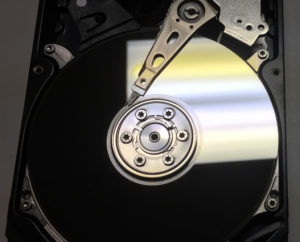A hard drive’s seek time is the time that the head assembly takes to travel to a specific track on the platters where data can be stored. Since seek time varies depending on which track it needs to access, “seek time” is usually expressed as an average.
Hard drives read and write data using magnetic charges. The head assembly must move across the platters to access those charges, which takes time, depending on where the heads are traveling relative to the position of the platters — but not much time.
Modern hard drives have an average seek time of around 9 milliseconds (9ms), but high-performance drives can cut this down to as little as 4ms.
Solid-state drives (SSD) have much faster seek times, since they don’t have moving parts: Even a fairly “slow” SSD has a seek time of around 0.16ms.
Below, we’ll explain why average seek time is useful as a hard drive performance metric. We’ll also explain its limitations — to fully evaluate HDD performance, you’ll need to look at a number of other factors.
Why Hard Drive Seek Time Is Important
Seek time is important because it’s the most basic way to express the physical speed of a hard drive’s actuator assembly.
Hard drive manufacturers have invested heavily in improving seek times. It’s particularly important for enterprise drives, which are used in RAID (Redundant Array of Inexpensive/Independent Disks) arrays to handle massive amounts of data transfer requests.

In those environments, seek time is a crucial metric. But for a typical computer user, this isn’t the case. For comparison, 10 milliseconds is 1/100th of a second. Unless you’re really, really good with a stopwatch, a 4ms seek time isn’t that much different than a 5ms seek time.
As a hard drive operates, seek time may be influenced by several factors, such as the fragmentation of the disk and the hard drive’s rotational speed. Rotational speed is measured in rotations per minute (RPM), and most desktop and laptop drives operate at 7200 RPM, though older drives may operate at 5400 RPM.
For optimal performance, a hard drive needs a fast actuator assembly and a fast spindle. A 7200 RPM will always be faster than a 5400 RPM drive with the same storage capacity.
Related: What is the Hard Drive Actuator Assembly?
Why Seek Time Isn’t a Perfect Predictor of Hard Drive Performance
Seek time is a component of a hard drive’s overall performance, but on modern devices, it’s not the most significant factor.
After locating the correct track on the platters, the heads still need to transmit the data to the computer. The head assembly can move quickly, but access time — the time from when the request is issued to when the read/write process begins — will always be slower. Additionally, the hard drive’s electronics board must interface with your computer, which introduces some bottlenecks.
For most consumers, the data transfer rate is a more effective metric than seek time. As the name implies, the data transfer rate expresses the rate (usually in megabytes per second, or MB/s) at which data transfer occurs.
A 7200 RPM hard drive may have a data transfer rate of 80-160MB/s. That’s fairly fast, but it pales in comparison to a typical SSD, which can attain a performance of as high as 550MB/s.
Related: What Is A Hard Drive Head Crash?
When buying a new hard drive, don’t forget about reliability.
In addition to these performance metrics, you should also consider the device’s predicted lifespan, mean time between failure (MTBF), warranty, and capacity when making your purchase.
Of course, no hard drive lasts forever — here, we’ll remind you to back up your data — but reliability is just as important as performance.
With our no data, no charge guarantee and risk-free media evaluations, Datarecovery.com offers the best resources for professional data recovery. If you’ve lost data due to a hard drive or SSD failure, we’re here to help. Get started by scheduling an evaluation online or call us at 1-800-237-4200 to discuss your case.





